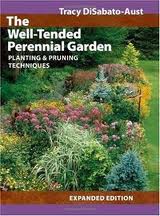Book Review: The Well-Tended Perennial Garden, by Tracy DiSabato-Aust
If perennial flowers are the backbone of your garden, as they are of mine, you may occasionally feel the need for an orthopedist. Keeping perennial flowers blooming, attractive, upright, adequately contained, and the right size and shape is an ongoing challenge. Experience and occasional expert advice are necessary to meet that challenge with reasonably consistent success.

That’s where The Well-Tended Perennial Garden comes in. Author Tracy DiSabato-Aust has written a useful and engaging book that should be read through once and then kept on hand as a reference work.
The first part of the book deals with staking, dividing, pruning, cutting back, bed preparation, rejuvenating old beds, and the intersection between plant maintenance and garden design. I found the sections on staking and cutting back to be particularly useful.
I grow a lot of wildflowers that exult in my fertile garden soil, often growing much taller than books and catalogs indicate they should. I usually end up cutting back AND staking a lot of these plants. And with all that, I may still end up struggling with floppers.
From reading DiSabato-Aust, I learned that I should probably be cutting back many plants earlier and harder. In some cases I should cut back a second time (I’m talking about you, New England Aster). I realized that my Wild Bergamot (Monarda fistulosa) didn’t bloom much this year probably because I cut it back too late in the season. And it turns out I could be cutting back the spires of Cardinal Flower (Lobelia cardinalis) for more compact plants, whereas I thought cutting back would result in no blooms at all, which is the case with Smooth Penstemon (Penstemon digitalis).

There were also some interesting ideas about staking I’d like to try out. For example, tying stakes in an X pattern holding back plants as a group, rather than vertically to individual plants. This could work with taller, bushier plants like asters and Monarda. I’m also curious, though a little skeptical, about using chicken wire with stakes. Can that really be done in a way where the chicken wire is not visible?

DiSabato-Aust appreciates that gardening is an art as much as it is a science. Few cookie cutter formulas can be applied because there are so many environmental variables. In addition, every approach to perennial maintenance involves trade offs: more compact plants versus delayed bloom, longer bloom time versus smaller flowers, etc. You cannot approach these trade offs without having a personal vision of the kind of space you want your garden to be.

The second part of The Well-Tended Perennial Garden is a guide to the maintenance of about 300 perennial species, with an emphasis on pruning. This section especially merits use as a reference book on its own, a valuable one because plants can differ dramatically in how they respond to being cut back, pinched, etc. In addition, there are lists of plants by maintenance characteristics.
I’m not ready to embrace everything that the author recommends here. For example, she is enthusiastic about peat moss in bed preparation, and declares it environmentally sound without any hint regarding the fact that others disagree.
Even so, The Well-Tended Perennial Garden is a stimulating and practical book that would enhance any gardener’s library.
The Well-Tended Perennial Garden: Planting and Pruning Techniques, by Tracy DiSabato-Aust, Timber Press, Portland OR, 2006.





I have has this book for a few years and I think the thing it really teaches you i not to be so precious about plants but to be more hard hearted
Yes, I think that is at the core of the book. It takes some of us a few years to realize that plants will not die if we do something wrong. And doing something really wrong is harder than you think. I’m kind of like that with computers also.
It sounds like a good book. But can you really cut back asters twice and still get blooms? I’m assuming the old “4th of July” rule still applies.
Yes you can! I’ve cut back a number of asters and still gotten lots of blooms: New England, Calico, Short’s. Generally I cut back in May or June.
Pinch, pinch, pinch…snip,snip,snip! Always good advice.
Have you been watching the Wizard of Oz?
Theres a reason it’s the best selling title from Timber Press, ever. Saw her speak while she was promoting the book. Very engaging personality.
Maybe I’m one of the last to get around to reading it.
I’m sold, my echinacea are driving me batty, falling over like a bunch of drunk spinsters….
Jen
I usually stake my echinacea, though I’m going to try cutting them back next year.
Now this is a practical book that I think I could really benefit from. Perennial plants are a bit of a challenge (to say the least!), and I think when mine are looking superb it is by luck rather than by design.
I’ve had the same experience, that’s why I did find this a useful book.
Joke is on me – I thought we grow perennials so we don’t have to spend so much time tending the garden. Shrubs are a different story – I need to do something about the boxwoods.
I’ve concluded that shrubs and grasses are really the easiest plants, unless you’re into topiary.
I love this book. I do much better with shrubs, but I’ve found that with her lists I can at least pretend to be a knowledgeable perennial gardener! ;0 This book deserves to have the recognition – I think it’s a must-have for every gardener.
I’d put in my top 10 most useful gardening books.
I too have cut back asters twice in one year. They are a great perennial. This is a great book too. Very straight talking and practical.
Asters are among my favorites, though they do tend to get overgrown.
Your post could not have come at a better time. I find that sometimes I wing it with some of my perennials. I could benefit from having more specific guidelines to follow as I grow as a gardener. I will be buying this one!
Glad I could point you to something you found useful.
Another great recommendation. Ain’t it wonderful to have excellent, fertile soil to start out with? I face some of these same issues during the growing season, so thanks for the recommendation.
This looks like a useful book as I try to stick to perennials and most of the plants I have are herbaceous. I hope it’s not too late to start dropping Christmas present hints. I should also take a look at those vibrant red cardinal flowers – they very arresting. I’m trying to remember the post you did a while back where you featured these too (post about red flowers?).